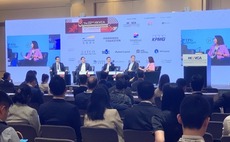
Asian outlier: Standard Chartered and secondaries direct

Over the past three years, Standard Chartered has completed Asia’s largest secondary direct deal and put its PE unit in a position to raise fresh capital. But it is not necessarily a harbinger of things to come
Through five transactions with an aggregate asset value of around $2.4 billion, Standard Chartered Private Equity (SCPE) may transpire to have used the secondary market to secure its future. "We think about this as a transition of our business model from a bank balance sheet to a best-in-class manager of high-quality institutional capital," says Joe Stevens, CEO of SCPE. "That's what we've been doing over the last three years."
The origins of this process were not unprecedented; commercial and regulatory factors meant that Standard Chartered was no longer able to maintain a captive principal investment business. But the process itself was in some respects unusual, notably the bank wanting to bring in third-party capital to relieve its balance sheet but hold on to the GP; and in others - the structure of the deal, the size of the direct portfolio that has been sold, the focus on emerging markets - it might be unique.
It is intended to catalyze SCPE's next fundraise by putting the GP into business with LPs that are long-term participants in the asset class. With a $1 billion-plus Asia, Africa and Middle East fund expected to launch this year, investors already benefiting from the existing portfolio are more likely to re-up.
Yet Asia's largest-ever secondary direct deal is hardly a bellwether. Volumes are increasing across the region, but the statistical spike of 2014 and 2015 perhaps warrants an asterisk in due to SCPE's status as an outlier. If there is a broader takeaway, it is that secondary direct transactions involving financial institutions are complex, nuanced, and not for everyone.
"With secondary direct transactions, the secondary price is only one of the evaluation criteria," says Dominik Woessner, a managing director at Greenhill Cogent. "Another important component is the GP set-up - the quality of the team, the compensation and incentive structure, and their alignment with the future investors."
Selling pressure
The timing of the Standard Chartered deal is largely due to the bank's geographic exposure. It was not at the epicenter of the global financial crisis so there were no distress-driven sales of PE portfolios on the secondary market. Indeed, for several years it benefited from the v-shaped recovery experienced by Asia, Africa and the Middle East. But when growth slowed and commodities prices slumped, profits turned to losses, jobs were cut and exposure to risk-weighted assets began to be trimmed.
There was also regulatory pressure in the form of Basel III and the Volcker Rule, which impose stricter capitalization levels and limit balance sheet exposure to alternative assets, respectively.
Standard Chartered decided against a complete spin-out of the PE unit - as many of its peers have done - because it recognized the role a captive GP can play in providing strategic equity solutions to clients and building boardroom relationships with companies that could ultimately become leading players in their still developing markets.
"Standard Chartered likes the fact that we put capital into companies that are either already clients of the bank or could become clients," says Stevens. "The Standard Chartered Bank franchise implicitly benefits from the fact that someone with a Standard Chartered business card is adding strategic value on a consistent basis over time. We have also generated pretty strong returns for the bank through our investments."
Neither was the SCPE team keen to sever ties with the bank. First, the ability to sift through the thousands of Standard Chartered clients spread across Asia, Africa and the Middle East is valued as a source of differentiated deal flow.
Second, it is useful to tap into the bank's institutional memory when operating in opaque markets. For example, a single phone call could identify a potential investee as a defaulter during the Asian financial crisis, and therefore a counterparty to avoid. Similarly, Standard Chartered's long-standing relationships with certain businesses can also open doors. "There is so much residual goodwill we can capitalize on," Stevens adds. "Even when we are competing, we are competing on a privileged basis."
Of SCPE's $5 billion in assets, half are still on the balance sheet, including around $700 million across an Asia real estate business that has a future and a distressed debt business that is being wound down. The other half is now under third-party ownership, with capital having been returned to the bank.
The first stage of this process, completed in the second half of 2013, saw Goldman Sachs acquire five assets, which were placed into a newly-formed limited partnership, according to sources familiar with the process. The SCPE team took a minority interest in the partnership. Management fees and carried interest - lower than the standard 2% and 20% - accrue to the bank but an agreed portion goes to the team.
The next two tranches in 2014 followed a similar process. Coller Capital led both, bringing in GIC Private and Abu Dhabi Investment Authority as co-investors in nine assets that comprised tranche two, and working with Goldman on 10 investments in tranche three. Then in 2015 Standard Chartered returned to the market with a portfolio of 17 investments. This was supposed to be a staple, with participation in the secondary conditional on committing to a new primary vehicle, but preparations for the primary piece took longer than expected.
Nevertheless, tranches four and five, which involve a single limited partnership, were structured with a view to cementing relationships with LPs that could back a future fundraise. LGT Capital Partners, Partners Group, Goldman Sachs and Blackstone Strategic Partners picked up the first tranche and were then joined by Rothschild and Unigestion in the second. The initial group holds 65% of the portfolio, the other two investors have 15%, and the bank has the rest.
Captive question
AVCJ spoke to various parties familiar with the process - having participated in it or looked at it - and others who commented on the challenges that come with secondary transactions involving financial institutions as sellers. A central issue for LPs is whether the team spins out alongside the assets, as was the case with NewQuest Capital Partners, formerly Bank of America Merrill Lynch's Asia PE team. If the GP remains captive, there are inevitably concerns about alignment of interest.
"In bank-related transactions, what becomes of paramount importance is understanding how aligned the team is with the ultimate buyers of the assets, given they are going to be providing the future dry powder," says Jason Sambanju, head of Asia secondaries at Deutsche Bank. "As long as there is a clear and unfettered understanding of this alignment the transaction should work out fine; anything short of that and the transaction might be challenged."
Steps can be taken to minimize potential conflicts between a GP's fiduciary responsibilities to the new third-party investors and its obligations as a unit of the bank. In addition to having the management team invest in the fund, giving it skin in the game, limited partnership agreements tend to include provisions on GP compensation, key man clauses that allow action to be taken in the event of certain people departing, and commitments to spend a minimum amount of time on the portfolio.
William Kirschner, a partner at Linklaters, adds that there have been so many spin-outs since 2008, documentation addressing other potential conflicts is reasonably standard. For example, protocols need to be established as to how the GP interacts with its parent in other aspects of financial services. Where a bank is providing acquisition financing or other services to the GP or to portfolio companies, an LP advisory board would typically need to sign off on decisions.
These measures, however, are largely routine protection. In order to go through with a deal involving a captive GP, investors need to augment this comfort with a fundamental belief in the quality of the team, its independence of mind, and its ability to stay together. This is particularly the case if an investment in a new primary fund is likely to follow the secondary. Such assessments are made on the back of due diligence conducted on the team, track record, and existing portfolio.
Speaking about SCPE specifically, several investors identify the GP's continued ties to its parent as a strength rather than a potential weakness. Echoing Stevens' earlier remarks, going in "with a Standard Chartered business card rather than an ABC Capital business card" gives the GP credibility and reach. There is an additional sense that in emerging markets being a captive can be a good thing. It is a compelling argument, but it is not necessarily enough to sway philosophical opposition.
Speaking about bank secondary deals in general, Lucian Wu, managing director at HQ Capital, is more circumspect: "It's kind of psychological. If you spin out entirely it's a new business and your future depends on it - you want to raise Funds II and III. If you remain captive, you may have some skin in the game by investing in the portfolio, but you are still part of an institution; there is no sense of ‘If I don't make it I'm going to die.' To me, that is important."
Additional challenges come in the form of valuations. Agreeing pricing for secondary deals is notoriously difficult and financial institutions as sellers are no exception. Standard Chartered, for example, is said to have been unwilling to sell below net asset value (NAV) and got its way on all bar the fifth tranche. This is a turn-off for some investors - one claims to have been less than enthused with a set of relatively young assets, based in emerging markets with exposure to macro, geopolitical and currency risk, priced at NAV, which was above cost.
Others, though, were able to get comfortable with it. First, much depends on the approach to valuation. If the seller is relatively conservative then there is room for upside, and this may be compounded by the investor conducting due diligence on individual portfolio companies and identifying strong growth potential, risk factors notwithstanding. Second, returns can be enhanced through financial engineering.
"You can address the issue so that from an IRR perspective, even though the transaction is being done at NAV, you get a boost from deferred payment arrangements," says another investor. "It fits in with the seller's bookkeeping but you don't pay on day one, you pay two years later."
The process has left SCPE managing four limited partnerships on behalf of about 10 third-party investors plus residual balance sheet assets. The scale of the operation is considerable - most GPs might have no more than three funds active at once, and at very different stages of their lifecycles - and it is not something that is likely to emerge again in Asia's secondaries space.
The real opportunity?
Both Adam Howarth, co-head of global secondaries at Partners Group, and HQ's Wu expect to see more traction from financial institution sellers now as the end-2017 deadline for implementing the Volcker Rule requirements nears. However, few direct portfolios of significant size are likely to become available. "While many small- and mid-size spinouts are yet to be done, a lot of the large-scale GP spinouts have already happened," Wu says.
For many investors, the principal secondary direct opportunity in Asia is independent funds that are nearing the end of their lives and struggling with realizations. Tail-end restructurings, where secondary players take out the existing LPs and spin the assets into a new vehicle, and staples are ways in which a GPs can return capital to investors and simultaneously engineer more time either to deliver returns or to secure a primary future.
"We are entering into what is probably going to be one of the toughest fundraising periods for Asian private equity and it is not going to let up for a while. Emerging markets have lost their flavor and now we are firmly back into the flight to safety mode for a lot of LPs. We will see more stapled secondaries and other fund restructurings," says Deutsche Bank's Sambanju.
Brooke Zhou, a managing director at LGT Capital Partners, concurs - noting that she is already seeing more secondary direct opportunities - but inserts a caveat: "There will continue to be a good flow, but as to how many get done, who knows."
This points to the uncertainty present in all secondary deals, albeit to varying degrees, which must be balanced against the time required to get them done. It is a pertinent issue for both LPs and GPs. The fourth tranche of the Standard Chartered deal - the largest of the five and the most open process - is said to have occupied the entire SCPE team for much of the first half of 2015 as prospective investors conducted due diligence on assets spread across the globe.
It was an arduous process, but an essential one. And the prize for getting to the end, with team intact, is a greater say over one's destiny. "We are at that point we've all been waiting for: we have significant assets under management, we have a vested interest in the portfolio and we continue to benefit from being part of the leading emerging markets bank; and we are well positioned for a first fundraise when it happens, with strong support from Standard Chartered and our blue chip investor partners," Stevens says.
Latest News
Asian GPs slow implementation of ESG policies - survey
Asia-based private equity firms are assigning more dedicated resources to environment, social, and governance (ESG) programmes, but policy changes have slowed in the past 12 months, in part due to concerns raised internally and by LPs, according to a...
Singapore fintech start-up LXA gets $10m seed round
New Enterprise Associates (NEA) has led a USD 10m seed round for Singapore’s LXA, a financial technology start-up launched by a former Asia senior executive at The Blackstone Group.
India's InCred announces $60m round, claims unicorn status
Indian non-bank lender InCred Financial Services said it has received INR 5bn (USD 60m) at a valuation of at least USD 1bn from unnamed investors including “a global private equity fund.”
Insight leads $50m round for Australia's Roller
Insight Partners has led a USD 50m round for Australia’s Roller, a venue management software provider specializing in family fun parks.







